|
47km north-east of Volos lies Zagora, situated on the verdant slopes of Mt. Pelion. The largest of the main villages of Pelion, it consists of four neighbourhoods: Aghia Paraskevi or Perachora, Aghia Kyriaki, Aghios Georgios and Sotira.
Zagora was built around the historic Monastery of the Transfiguration of the Saviour, founded in 1160, and enjoyed its heyday in the 17th-18th centuries.
The early inhabitants of the village worked in the manufacturing of silk and materials. Setting out from the picturesque harbour of Chorefto the boats of Zagori carried the renowned products of the region, building up a substantial trade by sea and establishing Zagora as an important commercial and spiritual centre for its time.
Zagoras first school was housed in the Saviour Monastery and was followed by that at Aghios Ioannis Prodromos. Later, with the support of the Patriarch Kallinikos III, a native of Zagora, this school, now known as the Ellinomouseio of Zagora, was upgraded to a Higher School.
It was here that several important national figures received their schooling, among them the hero of the War of Independence of 1821, Rigas Velestinlis.
Today the school library has more than 18,000 titles, including some rare manuscripts.
It is worth visiting the Zagora Ellinomouseio, and also the churches of Aghia Paraskevi and Aghia Kyriaki. In the three-aisled basilica church of Aghios Georgios you can see the carved wooden, gilded screen and exquisitely crafted pulpit, true works of art.
Make sure you visit the Womens Agrotourism Cooperative of Zagora and purchase the preserved fruit and various delicacies made with great enthusiasm from traditional recipes, handed down from generation to generation.

The neighbouring village of Pouri is located at 450m from sea level. Nearby is the highest peak on Pelion, the Pourianos Stavros, reaching a height of 1615m.
Visit the village square and enjoy the unique view across the Aegean. About halfway from Zagora to Pouri stands the picturesque chapel of Panayia Rasova (13th century).
Have a swim from the beaches of Elitsa or Ovrio, or at the picturesque little harbour at Chorefto, with its famous beach of sand and small pebbles.
Visit Makrirachi and buy some of the Pelion flowers, famous all over Greece - gardenias, camellias and hydrangeas. Take the road down to the sea, which leads you to the wonderful Agioi Saranta beach.

Hotels, rental rooms, restored old mansions, restaurants, tavernas, cafes - the area has facilities of every kind to meet the most demanding tastes.
Tsangarada, Mylopotamos, Fakistra
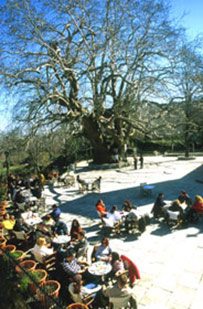 We come to Tsangarada by following the road on from Xourichti. Spread out over the hillside looking down on the Aegean, Tsangarada is a sea of green, centre of the Municipality of Mouresi and comprising four separate communities, each named after a saint (Aghion Taxiarchon, Aghia Paraskevi, Aghios Stephanos and Aghia Kyriaki). The village seems almost submerged in a sea of luxuriant vegetation, a place of innumerable natural charms and one of the largest and best-organized summer resorts on Pilion, attracting fiercely loyal visitors year after year. There are superb hotels, traditional guesthouses, restaurants with the highest standards of cuisine and attentive service and all sorts of shops, bars and clubs. This is a destination offering tourist amenities of the highest calibre.
We come to Tsangarada by following the road on from Xourichti. Spread out over the hillside looking down on the Aegean, Tsangarada is a sea of green, centre of the Municipality of Mouresi and comprising four separate communities, each named after a saint (Aghion Taxiarchon, Aghia Paraskevi, Aghios Stephanos and Aghia Kyriaki). The village seems almost submerged in a sea of luxuriant vegetation, a place of innumerable natural charms and one of the largest and best-organized summer resorts on Pilion, attracting fiercely loyal visitors year after year. There are superb hotels, traditional guesthouses, restaurants with the highest standards of cuisine and attentive service and all sorts of shops, bars and clubs. This is a destination offering tourist amenities of the highest calibre.
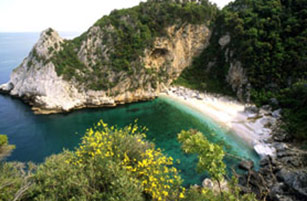
The visitor will want without fail to visit the picturesque, cool and shady village squares with their parish churches - Aghia Kyriaki, Aghioi Taxiarches and Aghia Paraskevi, the latter dominated by the ancient plane tree, one of the most characteristic sights of the region.
The cobbled streets wind their way past fine old houses in the traditional local style and beautifully made stone fountains.
At the beautiful beaches of Mylopotamos - which is internationally renowned - and Fakistra the visitor can enjoy crystal-clear water and a natural setting of extraordinary beauty: an unforgettable experience!
Aghios Ioannis (Ai-Yiannis), Aghios Dimitrios
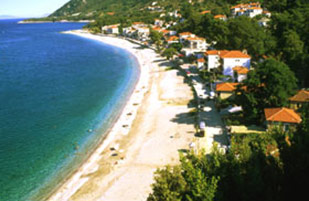 A picturesque village extending along a ridge of hills descending to the sea. It takes its name from the old monastery which once stood on the site of the splendid metropolitan church we now see. Scattered among the green fields are the chapels of Ai-Yiannakis, Aghios Georgios, the Panayia and Sotira (Virgin and Saviour), the latter with its piazza of the same name. All of the little churches have wall paintings and screens worth seeing. The village is currently developing into a summer resort with a growing tourist infrastructure. Well-maintained stone paths lead the visitor down from the village to the Ai-Yiannis beach.
A picturesque village extending along a ridge of hills descending to the sea. It takes its name from the old monastery which once stood on the site of the splendid metropolitan church we now see. Scattered among the green fields are the chapels of Ai-Yiannakis, Aghios Georgios, the Panayia and Sotira (Virgin and Saviour), the latter with its piazza of the same name. All of the little churches have wall paintings and screens worth seeing. The village is currently developing into a summer resort with a growing tourist infrastructure. Well-maintained stone paths lead the visitor down from the village to the Ai-Yiannis beach.
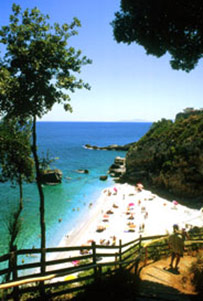 Aghios Ioannis was a forerunner in the development of tourism on Pilion, growing from a small fishing village into a famous resort; the beautiful setting - with its enchanting combination of mountain and sea - is alive with tourists every summer. It boasts a tourist infrastructure of very high quality, with superbly organized accommodation and well-run shops all along the promenade. On the other side of the promenade is the beach, running the whole length of the village, with some areas of sand and some of pebbles. Aghios Ioannis was a forerunner in the development of tourism on Pilion, growing from a small fishing village into a famous resort; the beautiful setting - with its enchanting combination of mountain and sea - is alive with tourists every summer. It boasts a tourist infrastructure of very high quality, with superbly organized accommodation and well-run shops all along the promenade. On the other side of the promenade is the beach, running the whole length of the village, with some areas of sand and some of pebbles.
Kissos
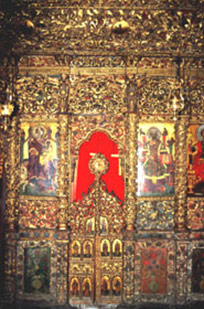
This is the highest of all the villages in eastern Pilion, a uniquely picturesque setting immersed in a sea of wild but tranquil vegetation, hidden away from the eyes of the uninitiated.
One of the best-known features of the village, and evidence of its former prosperity, is the 3-altar, three-aisled basilica of Aghia Marina, located in the beautiful village square. It is regarded as one of the finest examples of this kind of church anywhere on Pilion.
Now totally renovated, this famous church was decorated in the second half of the 18th century with one of the finest carved wooden screens on Pilion, and also boasts some fine religious and genre paintings and cool landscapes.
One of the chapels contains the villages Ecclesiastical Museum, where the visitor can see old icons and documents from the church archives.
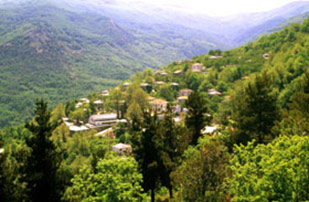
Other interesting ecclesiastical monuments include the little church of Aghios Efstathios, above the village, and the screen of the old church of Aghios Konstantinos, in Maroutsa, with its primitive carving.
Kissos combines fascinating natural beauty and history with top-quality tourist amenities.
Mouresi, Damouhari, Papa Nero
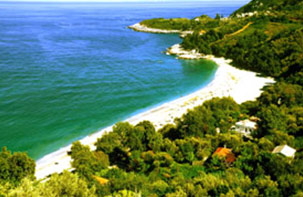
Magnesia Papa NeroMouresi is a sparsely populated but beautiful and prosperous village set amid lush greenery and enjoying a panoramic view of the Aegean and the nearby villages of Kissos, Aghios Dimitrios and Aghios Ioannis. It has much of interest to the visitor, including the beautiful village square, shaded by three huge lindens, and the metropolitan church of Aghia Triada.
The visitor should also make his way to Damouhari, with its wild and picturesque beauty, and to the Damouhari beach. Palia Damouhari is a fine pebble beach, while Kainouryia Damouhari has a natural harbour - the only one in eastern Pilion - and was once a busy haven for cargo vessels. Magnesia Damouhari
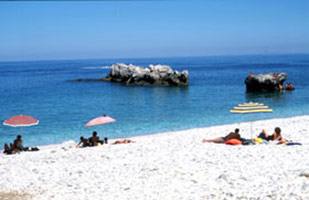
Among the interesting features in the area are the ruins of the mediaeval castle on the headland and the remarkable old monastery of Aghios Nikolaos. One of the beaches the visitor should definitely try is Papa-Nero - regarded by many as one of the most beautiful in Greece and beyond.
The whole Mouresi area offers welcoming accommodation, delicious food at the restaurants and little tavernas, and beautiful flowers from the local market gardens.
Anilio, Plaka
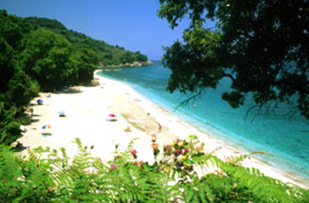
Magnesia PlakaFor the visitor coming along the mountain road via Hania, Anilio is the gateway to the Mouresi region. It lies in the shelter of a ridge of hills and probably acquired its name (Anilios = sunless) from the fact that in winter it rarely sees the sun.
You should visit the picturesque little village square, with its church of Aghios Athanasios, an important ecclesiastical building with one of the finest baroque carved wooden screens anywhere on Pilion. A number of well-known monasteries once thrived nearby - the Panayia ton Eisodion, Aghios Haralambos, the Ypsosi tou Timiou Stavrou and Aghia Triada monasteries among them.
Local tradition has it that the ancient city of Achilleio lay just below the village, founded by Achilles, the mythical hero. They also believe that the Centaur Cheiron frequented the cave on the shore at Banikas!
There is a beautiful beach at Plaka, with trees and plants extending right down to the edge of the crystal-clear waters. A good place to rest and enjoy traditional food, sweet dishes and drinks.
Xourichti, Limnionas
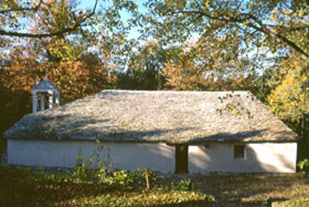
The village is situated on a verdant plateau, at the beginning of the Koutra ravine, the deepest on Pilion. The visitor will be awed by the wild beauty of the landscape. The road winds and curves like a stone snake as far as Xourichti, the other of the two villages which form gateways to the Municipality of Mouresi.
Limnionas - the beach closest to Xourichti - is a beautiful, peaceful natural beach, still unspoiled by development. The visitor can admire the beauty and tranquillity of the natural setting and the sea in all their majesty.
Those interested in the arts should definitely visit the picturesque little church of the Koimisis tis Theotokou (Dormition of the Virgin), which probably dates from the 17th century, but has since been renovated and features some interesting post-Byzantine religious paintings and a notable carved wooden screen.
Those who love country walks should make their way across the old bridge which links Xourichti to Tsangarada.
Source: https://www.magnesia-tourism.gr
|
